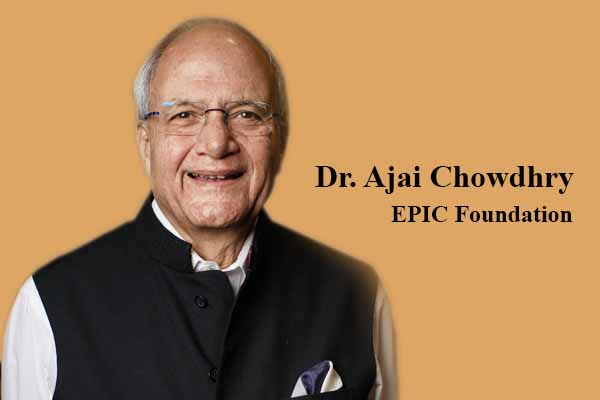Dr. Ajai Chowdhry founder of EPIC Foundation has been at the forefront of helping create the Electronics Industry in India. He was involved in Government Committees since 1999. In 2009 he headed a Task Force created by MEITY which made path-breaking recommendations where the task force warned that the electronics import bill will exceed the oil import bill. TimesTech Buzz interacted with Dr. Ajai to know about the Semiconductor and Core Electronics ecosystem in India.
Read the full interview here:
TimesTech: Industry 4.0 and IoT are fueling the electronics sector. PM said, “India is at the forefront of the Industry 4.0 revolution.” What is your macro-perspective about the electronics sector in India?
Ajai: There is no doubt that as a country, our focus is towards the industry 4.0 revolution, however, it will require time to succeed. There is room for improvement in how Industry 4.0 is being implemented in the electronics industry, as it is just getting adopted. Many sectors are beginning to adopt some of its components, such as the concept of additive manufacturing. This is being adopted by startups to build rockets as opposed to the earlier subtractive models, where objects were produced by cutting the metal into pieces. However, modern 3D printers are capable of creating designs layer by layer.
TimesTech: What are the requirements and challenges for Atmanirbhar Bharat in electronics in India?
Ajai: With global companies entering China and as a result of the WTO regime’s opening up, significant challenges were posed for the electronics industry in India. Hence, there is a great need to rebuild. To some extent, the effort has begun with the assistance of PLIs, however, they are currently intended for larger corporations. The government should develop more PLIs for SMEs as well and include both designing and manufacturing in them (similar to the Telecom PLI scheme).
India must also focus on developing Indian companies and brands, as well as designing and manufacturing products in India. That is exactly what the EPIC foundation wishes to assist and accomplish.
TimesTech: Discarded electronic devices contain many useful materials but there is no recycling facility available for them, especially in Tier-2 and Tier-3 cities and rural areas. How do you look at the problem of electronic waste in India?
Ajai: It is crucial to focus on the elimination of e-waste from India. In order to do that, we need to focus on the ‘Right to Repair’ policy and thereby, increasing the shelf life of electronic products. Phones, tablets and televisions are mostly non-repairable and therefore, it leads to a throw-away culture, which is a very western way of looking at things. In India, people want to extend the life of their products and that can only happen through repairs.
As a first step a ‘Right to Repair’ and ‘Repair Policy’ must be introduced and implemented. Secondly, there needs to be standardization in the collection of e-waste from both urban as well as rural areas of the country.
According to the current scenario, larger cities have more facilities for e-waste collection whereas smaller cities do not. There needs to be a model in place where collection centers are set up across the country to transport the material to e-waste factories and manage the e-waste.
The “Manufacturers policy” specifies that it is the manufacturers’ responsibility to bring back the products and therefore, it must be adhered to, by the manufacturers. Manual extraction of components from e-waste should not be allowed as it can be hazardous to human health due to the high level of chemicals it contains.
TimesTech: Local technicians and markets have already been there in major cities. Though, a grey market for electronics have been existing in India for years. How do you think India can create a green, sustainable and holistic ecosystem for electronic goods?
Ajai: Under a “repair policy system”, each manufacturer will be required to make their services manual and parts available. People will have the option of purchasing original components from manufacturers or avail of an alternative available in the market. Many repair businesses today have to experiment in order to fix the products, which frequently results in the products being ruined and sometimes results in the product being properly fixed.
There is wide accessibility of the courses from the Electronic Sector Skills Council to provide the required training & skills. The ability to repair is abundantly available in the Indian markets. However, the challenge is that we don’t have a repair policy in the country. Companies explicitly specify in their rules that the ‘warranty is void if the product is tampered with.” Today if your TV screen goes faulty, you have to replace the whole screen, which has a high cost associated with it. Repair policy could be revolutionary and attract thousands of repair businesses all over the country, repairing all sorts of electronic equipment.
TimesTech: Some years back government cancelled Hindustan Semiconductor Manufacturing Corporation’s permit to manufacture Semiconductors in India. Why companies are not coming forward to manufacture Semiconductors in India? What is the way forward?
Ajai: Earlier manufacturing corporations could not do a financial close and so did not happen. But the new semiconductor policy is much more open and attractive. We can expect at least 2-3 silicon fabs coming up in the next few years, with approvals expected to happen in the next 6 to 12 months. In addition, at least 2-3 compound semiconductor fabs and a couple of display semiconductor fabs coming up soon.
Additionally, as a result of an earlier MeitY approval, two semiconductor packaging plants are scheduled to operate in the next six months, and a few more are anticipated to be approved under the new policy. Schemes in our country are very attractive and many businesses have applied and are anticipating approvals.
Though the future looks promising with all the efforts being put in by the industry as well as the government. The way forward is clearly ‘Atmanirbharta.’ Only if we design and manufacture our products, there will be a market for semiconductors, which would not be possible otherwise.
TimesTech: How are Indian high-volume Electronics Products driving demand for Semiconductors?
Ajai: The demand for semiconductors is being driven by high-volume products like white goods, automobiles, etc. The 28nm that the government has proposed and for which people have applied is the right way forward for meeting the demand.
But this demand is linked to making our products. We cannot count on global players like Samsung and Apple to buy our chips. The demand will happen only when we produce our products to meet this demand.
TimesTech: Can semiconductor truly be ‘Made in India’ – your comments on it?
Ajai: They will unquestionably be ‘Made in India’. An American intelligence committee member said, “The next wars will be fought with the semiconductors”. So it is necessary for India to make semiconductors in India.
TimesTech: How adverse do you still see the chip shortage situation globally and vitally how the Indian market is reviving up during these exigent times?
Ajai: The Covid-19 disruption was a key contributor to the chip shortage. Work from home increased demand for some products, which were unable to be filled, leading to a chip shortage.
Only a small number of plants have been set up in the past four to five years, some of them came up in the last couple of years. But now many more are being set up globally. We might see a glut of semiconductors over the next 3-4 years. We can expect the current shortage to go away by mid of FY2023.

















